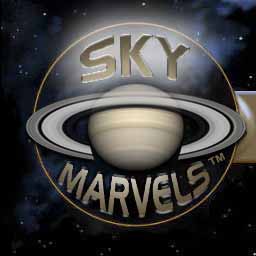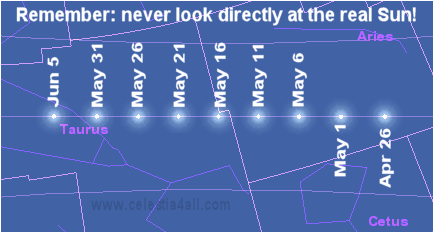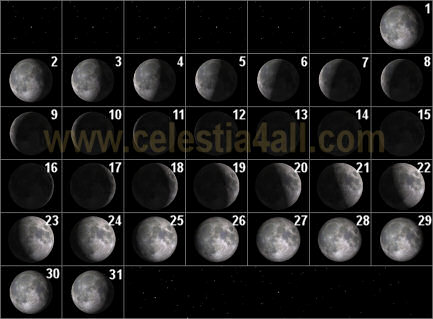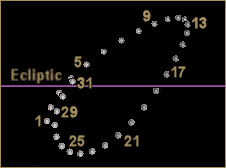








AVAILABLE MONTHS
2010:
Jan
Feb
Mar
Apr
May
Jun
Jul
Aug
Sep
Oct
Nov
Dec
2011:
Jan
Feb
Mar
Apr
May
Jun
APPARENT PATHS OF THE PLANETS
This month, Saturn continues its retrograde motion, right up until the last day of May. But Mercury makes its "U-turn" in about the middle of May.

MERCURY & VENUS: 2010 May
Mercury's retrograde motion continues through mid-May, and Venus moves eastward to precede the Sun through Taurus and into Gemini. And watch for the Moon occulting Venus on May 16 (1.6.x) (1.4.1).
MARS: 2010 May
Having completed its retrograde loop in March, in May Mars continues moving eastward out of Cancer and into Leo (1.6.x) (1.4.1). Because its orbit is relatively similar in size to Earth's orbit, Mars will not "go retrograde" again until early 2012.
Here again are the links that let you see Mars's entire retrograde loop of 2009-2010 (1.6.x) (1.4.1)
JUPITER, URANUS & NEPTUNE: 2010 May
Moving toward Uranus, Jupiter continues to move slowly eastward and into Pisces in May. Meanwhile, Uranus and Neptune move eastward in Pisces and Aquarius respectively, but very slowly. (1.6.x) (1.4.1)
SATURN: 2010 May
Slow-moving, distant Saturn continues its retrograde motion in Virgo until the end of May (1.6.x) (1.4.1)
Here again are the links that let you see Saturn's entire (though smallish) retrograde loop of 2010 (1.6.x) (1.4.1)
CELES-TIPS
The following will help you enjoy this page's many links that run events directly in CELESTIA. If you're new to the program, these tips will also help you learn to use it.
- If CELESTIA's clock (i.e. the program's date and time) is not visible at the top right of its window, press the V key until you see it. This will also turn on information text in other corners as well. This text will help you keep track of several aspects of the event you're viewing.
- Pressing the "un-shifted" L key and K key respectively will speed up and slow down CELESTIA's flow of time by a factor of 10 in version 1.6.x and 1.4.1.
- Pressing Shift+L and Shift+K respectively will speed up and slow down CELESTIA's flow of time by a factor of 2 in version 1.6.x only.
- Pressing the J key (either shifted or "un-shifted") will reverse CELESTIA's flow of time in version 1.6.x and 1.4.1.
HIGHLIGHT EVENT
MOON'S OCCULTATION OF VENUS 2010 May 16
To view this video in a larger size, click here.
THE SUN
APPARENT PATH OF THE SUN: 2010 May
Here are the Sun's positions along the Ecliptic at 00:00 UTC on the days shown.

The slightly curved lines above and below the Ecliptic show the extent of the Zodiac, which you may download from our Bonuses page and add to any version of CELESTIA. Note that the curve in the Zodiac lines is the result of CELESTIA's rendering in perspective.
 W A R N I N G ! It is never safe to look directly at the real Sun with the naked eye! Moreover, looking at it through a telescope or binoculars—even for an instant—can cause permanent blindness! NEVER DO IT! Consult the professionals at your local planetarium or observatory to learn how you can safely "observe" the Sun and any SOLAR eclipse!
W A R N I N G ! It is never safe to look directly at the real Sun with the naked eye! Moreover, looking at it through a telescope or binoculars—even for an instant—can cause permanent blindness! NEVER DO IT! Consult the professionals at your local planetarium or observatory to learn how you can safely "observe" the Sun and any SOLAR eclipse!
Of course, you can safely view CELESTIA's depiction of the Sun's apparent path in the sky in May. Here are the links: (1.6.x) (1.4.1). Note that versions 1.6.x and 1.4.1 differ in the way their "follow" and "lock" features work. If you "follow" Earth and then "lock" the Sun to it, versions 1.6.x and 1.4.1 respectively maintain the "attitudes" of the Ecliptic and the the Celestial Equator. This means that the Ecliptic remains "level" when you run the first link, but begins to tilt when you run the second! Differences like this will be discussed on our Help page.
HALF OF EARTH IN SUNLIGHT & DARKNESS
During your voyages in CELESTIA, would you like to be able to position yourself directly over the center of the half of Earth in sunlight or the half in darkness at any time this month? On our Tips page, you'll find that it's quite easy to do so! If you're any kind of sky watcher at all, you probably know just how helpful this can be!
THE MOON
PHASES OF THE MOON: 2010 May
In UTC per CELESTIA 1.6.x (& 1.4.1):
3rd Qtr: May 6, 4:16 (4:17). New: May 14, 1:05 (1:06).
1st Qtr: May 20, 23:43 (23:44). Full: May 27, 23:08 (23:09).
NOTE: New, 1st Quarter, Full and 3rd Quarter Moons respectively are defined to occur when the Geocentric Ecliptic Longitudes of the Moon and the Sun differ by 0°, 90°, 180° and 270°.

Produced with our "Moon Phase Calendar" script. The numbers of the days of the month were added with an image-editing program.
LUNAR PERIGEE & APOGEE: 2010 May
Per CELESTIA 1.6.x (and 1.4.1):
Apogee: May 6 21:55 (21:56) UTC; 404,233 km.
Perigee: May 20 8:40 (8:42) UTC; 369,731 km.
Determined by our "Earth-Moon Distance" and "Moon's Apparent Path" scripts. Note that distances given are the distances between Earth's and the Moon's centers.
LUNAR ANALEMMA: 2010 May
Here is the lunar analemma, generated by the Moon's positions relative to the mean lunar orbit and the Ecliptic at 0:00 UTC every day of May.

This phenomenon can be observed using our "Moon's Apparent Path" script. The analemma's change of shape month after month begins to give us an idea of just how irregular the lunar orbit is.
MOON'S OCCULTATION OF VENUS: 2010 May 16
As shown in the "Highlight Event" video at the top of this page, people in southeast Asia will be able to witness this impressive occultation of Venus by the Moon near sunset. Links follow so that you may recreate the event in CELESTIA (1.6.x) (1.4.1). In the next links (at the start of the occultation,) Venus is magnified, displaying its gibbous phase. Note that clouds are turned off to keep those of Earth from obscuring the event (1.6.x) (1.4.1). The next links show Venus emerging from behind the Moon (1.6.x) (1.4.1).
Back to Top
Home Intro News Gallery Sky-Gifts Bonuses Tips
Learning Ctr Help Links Credits Legal Contact Us
© 2007-
by Gary M. Winter. All rights reserved.
Interested in political cartoons and humor?
Check out The HIPPLOMATS™.
SkyMarvels, SkyMarvels: Your Key to the Sky and the Universe! Sky Marvels, SkyMarvels.com, celestia4all, celestiaforall, CELESTIA, astronomy, space, simulations, animations, downloadable astronomy posters, stars, planets, Inner Planets, Outer Planets, Inferior Planets, Superior Planets, moons, asteroids, comets, Oort Cloud, galaxy, galaxies, Milky Way, Andromeda, globular clusters, binaries, quasars, black holes, supermassive black holes, telescope, telescopes, planetarium, software, freestuff, satellites, add-ons, addons, scripts, eclipses, Solar Eclipses, Lunar Eclipses, Solar Eclipse Finder, Lunar Eclipse Finder, mutual eclipses, transits, occultations, Solar System, CELES-TOOLS, celeSTARrium, CELX, CELX programming, Freebies, Bonuses, multiple views, atronomical unit, light year, parsec, meteors, meteor showers, Perseids, Geminids, Leonids, barycenter, time, Time Zones, tides, alignments, conjunctions, oppositions, seasons, apogees, perigees, aphelion, perihelion, Earth, Luna, Mercury, Venus, Mars, Jupiter, Galilean Moons, Io, Europa, Ganymede, Callisto, Saturn, Titan, rings, Uranus, Neptune, Triton, E-MSpectrum, electromagnetic spectrum, astronaut, equinoxes, solstices, precession, rotation, spin, inclination, tilt, Ecliptic, orbits, ellipse, parabola, hyperbola
Donate safely with: PayPal
to receive one or more
Sky-Gifts. Your support is greatly appreciated!
Various astronomical "shadow events" occur throughout the Solar System! This month's more interesting ones are featured here.
SHADOW WORKS
Here we highlight (and set up) the most awe-inspiring eclipses taking place in our Solar System, so that all you need to do is click on their links. Don't forget that you can generate lists of Earth's, Jupiter's, Saturn's, Uranus's, Neptune's and even Pluto's eclipses, using CELESTIA's own built-in "Eclipse Finder." You'll find it in the program's menu under "Navigation".
All events listed below are displayed as if viewed from Earth, their magnifications shown in parentheses at the lower right of CELESTIA's window. Events involving more than one moon are often cyclical, so usually only the first example is given, and then the period of the cycle.
 JUPITER
JUPITER
Simultaneous solar eclipses do not occur on Jupiter in May, because Io, Europa, Ganymede and Callisto—the "Galilean" moons—are a bit "spread out" in their orbits this month. Nonetheless, here are highlights of the 31 solar eclipses they produce. You'll note that Jupiter's shadow stretches off to the west (right on your screen) and, as always, examples of the Galilean moons moving through it are also included.
- May 2: Io having passed Europa last month, they cast shadows on Jupiter one after the other in a cycle that repeats about every 3½ days; (1.6.x) (1.4.1)
- May 4: having cast its own shadow hours before, distant Callisto moves in front of Jupiter after Io begns casting its shadow; (1.6.x) (1.4.1)
- May 8: the second most distant Galilean, Ganymede emerges from Jupiter's shadow to the west (right) (1.6.x) (1.4.1)
- May 20: continuing the May 2 cycle, first Io casts its shadow, and then Europa does likewise; a little later Callisto also casts its shadow (1.6.x) (1.4.1)
- May 23: Ganymede and Io emerge from behind Jupiter (1.6.x) (1.4.1)
- May 29: as Callisto gets ready to move behind Jupiter, Europa emerges (1.6.x) (1.4.1); and in an odd coincidence a half day later, Ganymede and Io perform a similar act (1.6.x) (1.4.1)
 SATURN
SATURN
While CELESTIA 1.6.x shows the shadows of Titan, Rhea, Iapetus, Dione and Tethys, version 1.4.1 displays only the shadows of Titan, Rhea & Iapetus. So, 1.6.x and 1.4.1 respectively show 34 and 7 solar eclipses on Saturn in May. The highlights are as follows:
- May 2: Tethys casts its shadow on Saturn, as it currently does about every 2 days (1.6.x only)
- May 2: Rhea casts its shadow on Saturn, as it currently does about every 4½ days (1.6.x) (1.4.1)
- May 3: Dione casts its shadow on Saturn, as it does about every 2¾ days (1.6.x only)
- May 11: Rhea and Tethys cast their shadows on Saturn simultaneously (1.6.x only)
- May 19: Tethys and Dione cast their shadows on Saturn simultaneously (1.6.x only)
- May 24: Dione and Tethys cast their shadows on Saturn simultaneously (1.6.x only)
URANUS, NEPTUNE & Dwarf Planet PLUTO
Neither Uranus nor Neptune will experience eclipses for decades. Dwarf planet Pluto will experience no eclipses by Charon for about a century!












